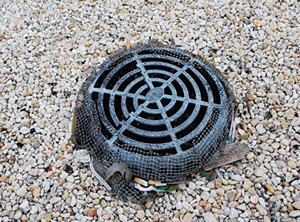
|
| A joint ASPE/IAPMO standard on roof-drainage systems is in draft form and will be soon set for public review. Photo credit: Julius Ballanco |
How much water goes down the roof drain you specified?
That should be a question every engineer asks before specifying a roof drain. Unfortunately, it is the most forgotten question in engineering design. Have we become too lazy to properly design a roof-drainage system?
A joint ASPE/IAPMO standard will help engineers answer the question regarding how much water flows down a roof drain. This standard is currently in the draft form and is about to be set for public review. If you have never reviewed a standard during the public review period, I would encourage you to do so with this item.
The testing of roof drains for flow performance has not been without controversy. Here’s a little background to start. The ASPE Research Foundation shook the plumbing engineering profession when the group published its paper on roof drainage. The paper states that we have been incorrectly designing roof drainage systems for more than 80 years.
The ASPE RF report suggests changes to the plumbing codes to properly size a roof-drainage system. The ICC International Plumbing Code accepted those changes and the 2015 edition of the International Plumbing Code will require engineers to design a roof-drainage system based on the flow rate through the drain. This begs the question: How much water goes down the roof drain?
It should be noted that a similar change to the IAPMO Uniform Plumbing Code is currently pending.
As can be understood, roof drain manufacturers are not crazy about having to test all their roof drains to a new standard. So, this standard is trying to make it as reasonable as possible to test roof drains.
One of the hotter topics deals with whether the roof drain should be tested connected to pipe or without any piping. The ASPE RF report clearly establishes that a roof drain performs better with a pipe connected vs. no pipe.
When the roof drain was simply tested open to the atmosphere, the flow rate through the roof drain was at its lowest. A 10-ft. piece of pipe connected to the roof drain and directed vertically downward produced the highest flow rate. When a 5-ft. horizontal offset was placed below the roof drain, the flow rate was less than the vertical pipe, but much greater than the roof drain without any pipe connected.
It has been suggested that roof drains should be tested without any piping. Once that value is established, an engineer can figure out the impact of the piping when connected to the roof drain.
Doing the math
I always thought that I was a pretty knowledgeable engineer, yet I still asked the question: What equation do we use to determine that flow rate? I hate it when the answer is something such as, “You’re the engineer.” That seems to indicate there are no equations to make such a calculation.
You may be thinking, use the lowest flow rate (no piping connected) and figure that when you connect pipe you’ll get more water off the roof. It sounds like a good idea, but only as it applies to the roof. If the roof drain flows more water than what is reported by the manufacturer, the water simply is removed off the roof that much faster.
But, you need to ask, what happens in the piping? If more water goes down the roof drain than is originally considered, the piping system becomes undersized. The problem with the roof-drainage system switches from the roof to the piping. Unfortunately, it appears there have been more failures related to the piping system than to the roof.
If you decide that pipe should be connected to the roof drain for testing, how long should that pipe be? Once you figure out the length, what should the piping configuration be? The longer the pipe, the bigger the test rig for testing roof drains. However, some testing has shown that the shorter the pipe is the lower the flow through the roof drain.
The current version of the ASPE/IAPMO draft standard requires roof drains to be tested in two configurations: one with a 10-ft. vertical section of pipe connected to the roof drain, the other with a 5-ft. horizontal offset below the roof with an overall vertical drop of 10 ft. The end of the pipe is open to the atmosphere located above the tank that collects the water in the test rig.
An alternative to the piping arrangement described in the standard would be any arrangement that provides equivalent results. The only way to determine equivalent results is to compare the flow rates through an opening without a roof drain and compare those numbers to the ASPE RF report.
The ASPE RF report first tested the equipment without any roof drains connected. This was intended to establish a baseline number for every piping arrangement. The draft standard also proposes a suggested means for reporting the results and the intent is for this information to be useful to the engineer designing the roof-drainage system. Please take a look at what is proposed to see if the proper information is being reported.
While this new test standard is directed toward the manufacturers and test laboratories, it is really producing information that will become useful to the engineer. Most manufacturers don’t care how much water goes down a roof drain. They are concerned with producing a roof drain that meets the material and dimensional requirements in the roof drain standard.
In reality, this new standard is for the engineering community and will result in providing information to the engineer in order to properly design a system. Without knowing how much water goes down a roof drain, it is not possible to properly design a system.
Both ASPE and IAPMO will announce the availability of the standard for public review on their respective websites. Keep an eye open and review the draft standard.
Let the committee know what you think.



